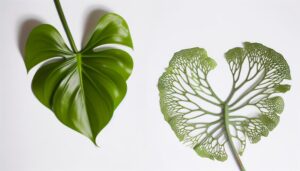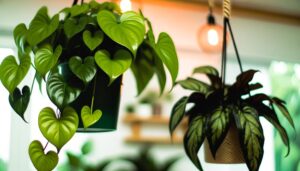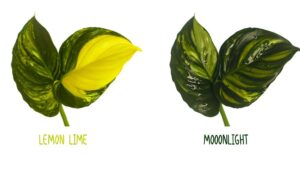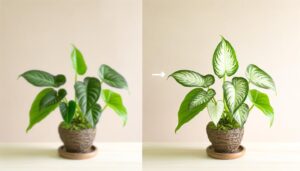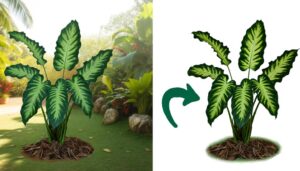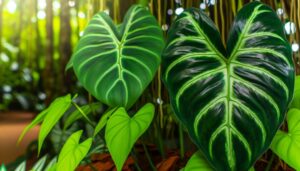Philodendron Gigas Vs Melanochrysum: Key Differences!
Philodendron gigas and Philodendron melanochrysum are tropical plants native to Central and South American rainforests. Philodendron gigas features large, velvety, elongated leaves with a bronze sheen, while Philodendron melanochrysum has smaller, heart-shaped leaves with a deep, almost black-green color and prominent veins.
The former grows slower, spreading wider, and prefers moderate indirect light, whereas the latter grows quickly, climbing, and thrives in bright indirect light. Watering needs vary, with gigas requiring more frequent watering than melanochrysum.
Both plants necessitate humid environments and well-draining, nutrient-rich soils. Explore further to understand their care and growth intricacies.
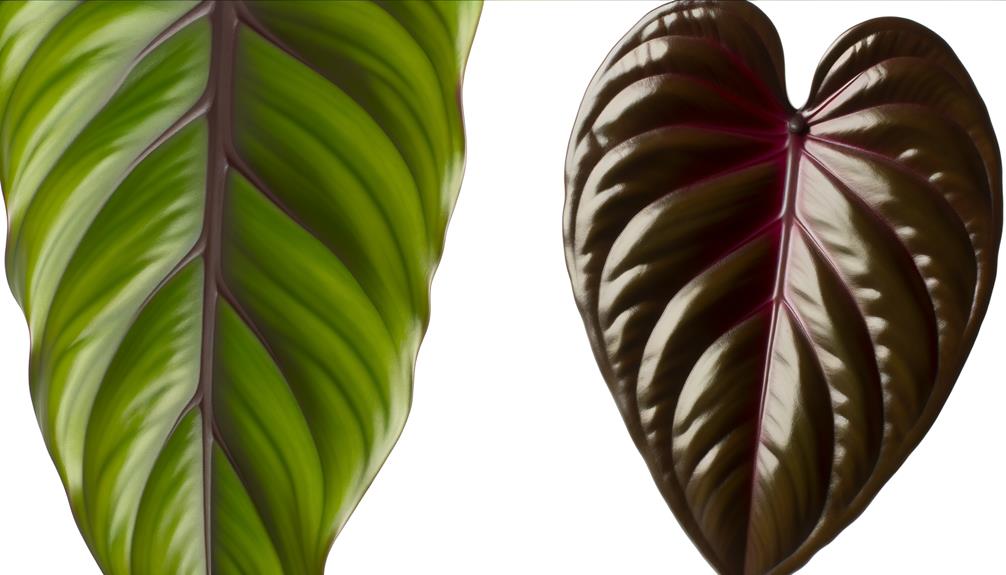
Comparison of Philodendron Gigas and Philodendron Melanochrysum
| Feature | Philodendron Gigas | Philodendron Melanochrysum |
|---|---|---|
| Leaf Size | Larger, can grow up to 3 feet long | Smaller, typically up to 2 feet long |
| Leaf Shape | Elongated heart-shape | Elongated, more narrow |
| Leaf Texture | Velvety | Velvety |
| Leaf Color | Dark green with reddish undersides | Dark green with iridescent sheen |
| Leaf Veins | Prominent, light-colored | Less prominent |
| Growth Habit | Climbing | Climbing |
| Rarity | Rarer, less common in cultivation | More common in cultivation |
| Light Preference | Bright, indirect light | Bright, indirect light |
| Humidity Needs | High | High |
| Temperature Tolerance | Prefers warm temperatures | Sensitive to cold and dry conditions |
Origins and Natural Habitat

Philodendron gigas and Philodendron melanochrysum both originate from the tropical rainforests of Central and South America, where they thrive in the humid, shaded understory layer. These rainforests provide an ideal environment characterized by high humidity, consistent temperatures ranging from 20°C to 30°C, and diffuse light filtered through the dense canopy.
This microenvironment ensures that both species receive adequate moisture and reduced direct sunlight, which is essential for their growth. The understory habitat also provides a rich, organic substrate that is necessary for their root development.
Additionally, the epiphytic nature of these philodendrons allows them to climb trees, maximizing their exposure to light while remaining anchored to the forest floor for nutrient absorption.
Leaf Shape and Size
The Philodendron gigas and Philodendron melanochrysum exhibit distinct leaf morphology, each characterized by unique shapes and textures.
Philodendron gigas leaves are typically larger, with an elongated, velvety surface, whereas Philodendron melanochrysum presents smaller, heart-shaped leaves with a glossy finish.
Comparative analysis of their leaf dimensions reveals significant differences in length and breadth, contributing to their distinct visual appeal and functional attributes.
Distinct Leaf Morphology
Distinct differences in leaf morphology between Philodendron gigas and Philodendron melanochrysum are evident in their unique leaf shapes and sizes, contributing greatly to their identification and classification.
Philodendron gigas exhibits elongated, heart-shaped leaves with a leathery texture and pronounced venation, giving it a robust appearance. The leaves are typically darker green with a velvety sheen, accentuating their luxurious aesthetic.
In contrast, Philodendron melanochrysum features more elongated, lanceolate leaves that are narrower and more tapered at the ends. These leaves possess a velvety texture but are characterized by a subtler, almost matte finish, and lighter green tones.
The distinct leaf morphology of each species underscores the taxonomic and horticultural distinctions essential for botanists and enthusiasts alike.
Comparative Leaf Dimensions
Examining the comparative leaf dimensions of Philodendron gigas and Philodendron melanochrysum reveals significant disparities in both shape and size, which are critical for accurate species identification.
Philodendron gigas exhibits elongated, lanceolate leaves, reaching lengths of up to 3 feet and widths around 12 inches. These leaves are characterized by their dark green hue and prominent veining.
Conversely, Philodendron melanochrysum presents more ovate, heart-shaped leaves, typically measuring up to 2 feet in length and 8-10 inches in width. The leaves of P. melanochrysum feature a velvety texture and a dark, almost black-green coloration, accentuated by contrasting light green veins.
Understanding these dimensional differences is essential for botanists and horticulturists in distinguishing between these two species.
Leaf Color and Texture
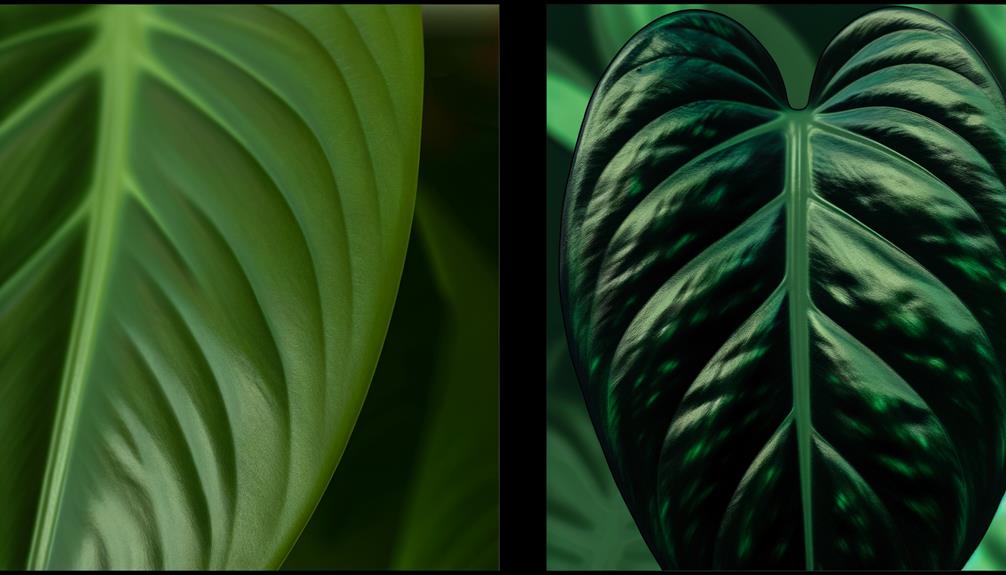
Philodendron gigas exhibits deep green, velvety leaves with a subtle bronze sheen, while Philodendron melanochrysum features darker, almost black-green leaves with a distinctly velutinous texture. The differences in leaf color and texture between these species are critical for accurate identification and cultivation.
Philodendron gigas:
- Deep green leaves
- Velvety texture
- Subtle bronze sheen
- Enhanced light reflection
Philodendron melanochrysum:
- Dark, almost black-green leaves
- Velutinous texture
- Prominent leaf veins
- High contrast in coloration
These characteristics are essential for enthusiasts and botanists aiming to distinguish between the two species, contributing to their unique aesthetic and ecological adaptability. Understanding these traits aids in optimizing care and ensuring healthy growth.
Growth Rate and Patterns
The growth rate and patterns of Philodendron Gigas and Philodendron Melanochrysum exhibit distinct characteristics crucial for horticultural planning.
Philodendron Gigas generally demonstrates a slower growth rate compared to the relatively rapid expansion of Philodendron Melanochrysum.
Additionally, while Philodendron Melanochrysum typically adopts a climbing growth habit, Philodendron Gigas exhibits a more sprawling and bushy pattern, influencing their respective support and spatial requirements.
Growth Speed Comparison
Comparing the growth speed of Philodendron gigas and Philodendron melanochrysum reveals distinct differences in their growth rates and patterns, which are influenced by their respective genetic and environmental adaptations.
Philodendron gigas typically exhibits a faster growth rate, characterized by larger leaf production and more rapid elongation of stems.
Conversely, Philodendron melanochrysum grows more slowly but produces leaves with a distinctive velvety texture and deep coloration.
Key differences include:
- Growth Rate: Gigas grows approximately 1.5 times faster than Melanochrysum.
- Leaf Size: Gigas develops larger leaves more quickly.
- Stem Elongation: Gigas shows more pronounced, faster stem elongation.
- Environmental Sensitivity: Melanochrysum requires more stable conditions for best growth.
Understanding these growth patterns can guide cultivation strategies for each species.
Climbing Versus Sprawling
When evaluating the growth rate and patterns of climbing versus sprawling, it becomes evident that the structural morphology and adaptive strategies of Philodendron gigas and Philodendron melanochrysum result in significant differences in their spatial development.
Philodendron gigas exhibits a pronounced climbing tendency, deploying aerial roots for anchorage on vertical surfaces, which facilitates upward growth and maximizes light capture.
Conversely, Philodendron melanochrysum also demonstrates climbing behavior but does so with a more compact and slower vertical ascent, often producing larger leaves. This species prefers to cling tightly to supports, resulting in a denser, more controlled growth habit.
Both species require support structures to achieve best growth, but their differing rates and patterns underscore their unique adaptive mechanisms within their native habitats.
Light Requirements

Ideal light requirements for Philodendron gigas and Melanochrysum differ slightly due to their unique physiological adaptations to their native habitats.
Philodendron gigas, originating from the Panamanian rainforests, thrives best in moderate indirect light. Conversely, Melanochrysum, native to Colombian forests, prefers bright indirect light. Both plants exhibit prime growth when their specific light conditions are met.
Key light requirements include:
- Philodendron Gigas: Moderate indirect light, avoiding direct sunlight to prevent leaf burn.
- Melanochrysum: Bright indirect light, which enhances its velvety foliage’s vibrancy.
- Commonality: Both species benefit from consistent light exposure for photosynthetic efficiency.
- Artificial Lighting: Can supplement natural light, especially in low-light indoor environments, using full-spectrum LED grow lights.
Watering Needs
When evaluating the watering needs of Philodendron Gigas and Melanochrysum, both species show unique requirements regarding frequency and soil moisture levels.
Philodendron Gigas usually requires more regular watering to keep soil consistently moist, while Melanochrysum thrives with a more regulated schedule, letting the top layer of soil slightly dry between waterings.
Grasping these distinctions is essential for maximizing growth and avoiding problems like root rot.
Frequency of Watering
Understanding the specific watering needs of Philodendron Gigas and Melanochrysum is crucial for their finest growth and health. Both species thrive under conditions that balance moisture without inducing root rot. Philodendron Gigas generally requires less frequent watering compared to Melanochrysum.
To enhance their care, consider the following guidelines:
- Philodendron Gigas: Water approximately once every 7-10 days, making sure the top inch of soil dries out between waterings.
- Melanochrysum: Requires more frequent watering, approximately every 5-7 days, maintaining consistently moist, but not waterlogged, soil.
- Seasonal Adjustments: Reduce watering frequency during colder months to prevent overwatering.
- Environmental Factors: Adjust watering based on humidity levels and temperature, as higher humidity can reduce the need for frequent watering.
These practices ensure prime hydration for both species.
Soil Moisture Levels
Maintaining appropriate soil moisture levels is crucial to the health of both Philodendron Gigas and Melanochrysum, requiring a careful balance that supports hydration without leading to root rot.
Optimal soil moisture should be defined by a consistently moist substrate, avoiding both waterlogged conditions and complete dryness. Using a well-draining potting mix, such as one incorporating peat, perlite, and orchid bark, guarantees sufficient aeration and moisture retention.
Regularly monitoring soil moisture through tactile assessment or moisture meters can prevent over- or under-watering. These species thrive when the top inch of soil is allowed to dry slightly between watering sessions, indicative of an environment that imitates their native tropical habitats, thereby fostering robust root development and overall plant essentiality.
Soil Preferences
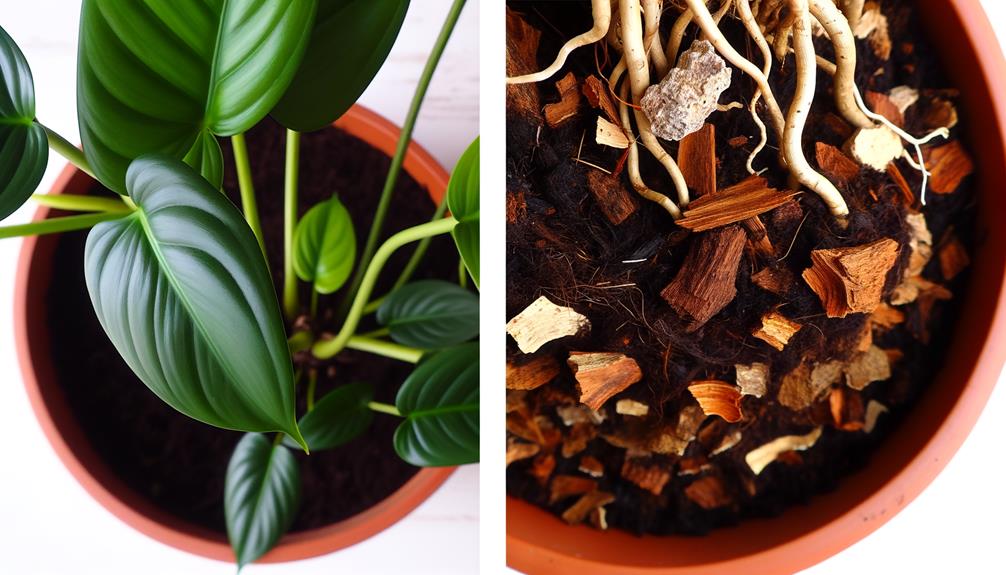
Perfect soil conditions for Philodendron gigas and Philodendron melanochrysum are crucial for their growth. These species require a well-draining, nutrient-rich substrate to prevent root rot and ensure proper aeration. Both species thrive in a soil mix that mimics their native tropical environments.
Key components of a perfect soil mix include:
- Perlite or Pumice: Improves drainage and prevents soil compaction.
- Coconut Coir or Peat Moss: Retains moisture while maintaining a light and airy structure.
- Orchid Bark: Offers chunky texture for better root aeration.
- Worm Castings: Provides essential nutrients and promotes healthy root development.
This combination guarantees optimal moisture retention and drainage, which are crucial for the health and vitality of these philodendrons.
Temperature and Humidity
In addition to ideal soil conditions, Philodendron gigas and Philodendron melanochrysum require specific temperature and humidity levels to thrive, reflecting their native tropical habitats.
Both species flourish in temperatures ranging from 65°F to 80°F (18°C to 27°C). It is essential to avoid exposing these plants to temperatures below 55°F (13°C) as it can lead to stress and potential damage.
Humidity is equally important; both Philodendrons prefer humidity levels between 60% and 80%. Insufficient humidity can result in leaf browning and reduced growth rates. Employing humidifiers or pebble trays can help maintain the best humidity.
Regularly monitoring environmental conditions ensures these plants replicate their natural habitat, promoting robust health and growth.
Fertilization Tips
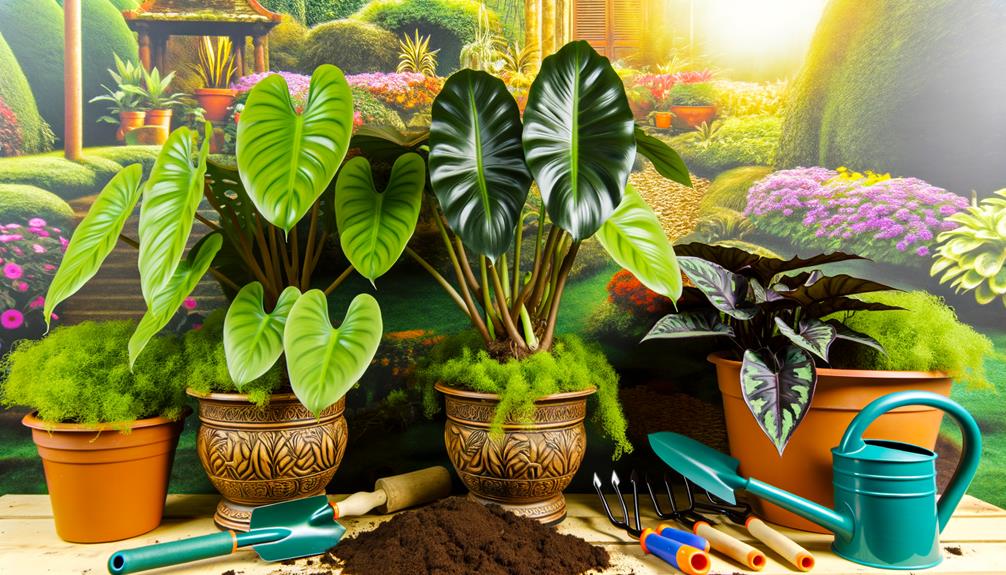
Effective fertilization is essential for the finest growth and vibrant foliage of Philodendron gigas and Philodendron melanochrysum, necessitating a balanced nutrient regimen tailored to their specific needs. Both species thrive on a nutrient-rich substrate that supports their unique metabolic requirements.
To achieve peak fertilization, adhere to the following guidelines:
- Use a balanced liquid fertilizer with an N-P-K ratio of 20-20-20, diluted to half strength, applied bi-weekly during the growing season.
- Incorporate micronutrients such as iron, magnesium, and calcium to prevent deficiency symptoms.
- Avoid excessive fertilization, as it can lead to root burn and salt buildup in the soil.
- Flush the soil periodically to remove excess salts and promote healthy root growth.
These practices guarantee sustained plant health and development.
Common Pests and Diseases
Philodendron gigas and Philodendron melanochrysum are susceptible to a variety of pests and diseases that can hinder their growth and health, including aphids, spider mites, and fungal infections. These issues often arise due to suboptimal environmental conditions such as inadequate humidity or poor air circulation. A thorough understanding of these threats is essential for maintaining plant vitality.
| Pest/Disease | Symptoms |
|---|---|
| Aphids | Yellowing leaves, sticky residue |
| Spider Mites | Webbing, speckled foliage |
| Mealybugs | Cotton-like masses on leaves |
| Root Rot | Wilting, brown roots |
| Fungal Spots | Brown or black leaf spots |
Proactive measures, including regular inspection and maintaining ideal conditions, are necessary in mitigating these risks. Employing natural predators or appropriate treatments can also effectively manage infestations and infections.
Propagation Methods
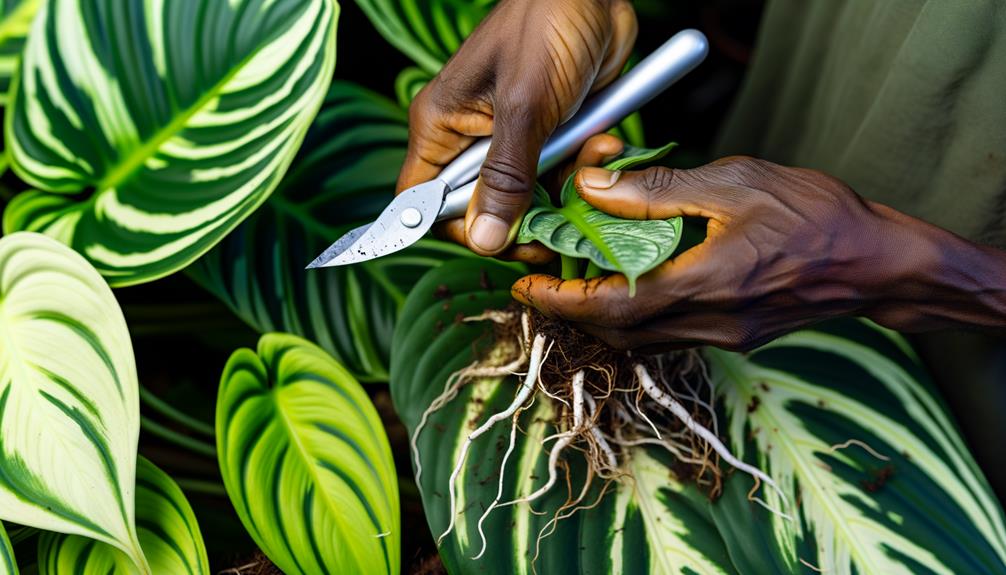
Understanding the propagation methods of Philodendron gigas and Philodendron melanochrysum is vital for enthusiasts aiming to expand their collections or support the continuity of these species. Both plants can be propagated through stem cuttings, which is a reliable method for asexual reproduction.
The process largely entails the following steps:
- Selection of Healthy Stem: Choose a healthy, pest-free stem with at least one node and aerial root.
- Cutting: Use sterilized scissors to make a clean cut below the node.
- Rooting Medium: Place the cutting in either water or a well-draining substrate, such as sphagnum moss or perlite.
- Environmental Conditions: Maintain high humidity and indirect light to facilitate root development.
These techniques guarantee successful propagation and growth of both species.
Care and Maintenance
Proper care and maintenance of Philodendron gigas and Philodendron melanochrysum involve meticulous attention to their specific environmental and nutritional requirements. Both species thrive in high humidity levels, ideally between 60-80%, and prefer temperatures ranging from 65-80°F. Adequate indirect light is essential, as direct sunlight can scorch their leaves.
Use a well-draining, aerated soil mix rich in organic matter to prevent root rot. Regular fertilization with a balanced, water-soluble fertilizer during the growing season promotes best growth. Watering should be consistent but allow the top inch of soil to dry out between waterings.
Pruning dead or yellowing leaves and providing structural support are vital for maintaining plant health and aesthetics.
Conclusion
In the intricate dance of botanical wonders, Philodendron gigas and Philodendron melanochrysum emerge as paragons of foliage elegance. Their distinct origins and habitats, diverse leaf morphologies, and unique growth patterns encapsulate the splendor of nature’s design.
Best care—encompassing precise light, fertilization, and pest control—ensures their thriving. Propagation methods further extend their legacy.
These species, akin to the legendary flora of ancient texts, exemplify the profound beauty and complexity inherent in plant cultivation.

